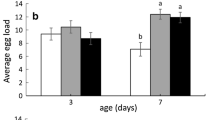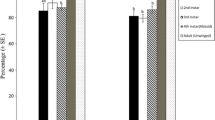Summary
Host type choice and sex allocation were examined using the solitary parasitic waspDinarmus basalis (Pteromalidae, Hymenoptera) parasitizing larvae or pupae of the bean weevilCallosobruchus chinensis (Bruchidae, Coleoptera) within azuki beans (Vigna angularis). The wasps were offered two types of host; one was hard for the mother to lay eggs in, but was more beneficial for the offspring; the other was easy for the mother to lay eggs in, but was less beneficial for the offspring. The two types of host were one large host (17-day old host) in one bean and 6 small hosts (12-, or 13-day old hosts) in one bean. The same number of each host was presented at the same time to female wasps. The wasps accepted more 17-day old hosts than 12-day old hosts, and more 13-day old hosts than 17-day old hosts in each pair-wise choice experiment. The proportions of accepted host types were different from the proportions predicted by optimization models of random prey encounter with known or unknown prey densities. The wasps showed partial preference of host types. Incomplete information about prey densities, and about the costs and benefits of the two types of host may have generated the partial preference. Two predictions of host sizemodels, that (1) there should be a negative relationship between host size and offspring sex ratio (proportion of male offsprings), and (2) the sex ratio in each size host changes with the relative frequency of each size host utilized, were qualitatively supported.
Similar content being viewed by others
References
Charnov, E. (1976) Optimal foraging: the marginal value theorem.Theor. Popul. Biol. 9, 129–36.
Charnov, E. (1979) The genetical evolution of patterns of sexuality: Darwinian fitness.Am. Nat. 113, 465–80.
Charnov, E. (1982)The Theory of Sex Allocation. Princeton University Press, New Jersey, USA.
Charnov, E., Los-den, R. L., Jones, W. T. and van dem Assem, J. (1981) Sex ratio evolution in a variable environment.Nature 289, 27–33.
Emlen, J. M. (1973)Ecology: An Evolutionary Approach. Addison-Wesley, New York, USA.
Fujii, K. and Khim Mar Wai (1990) Sex-ratio determination in three wasp species ectoparasitic on bean weevil larvae.Bruchids and Legumes: Economics, Ecology and Coevolution, pp. 331–40. Kluwer, New York, USA.
Heinz, K. M. (1991) Sex-specific reproductive consequences of body size in the solitary ectoparasitoidDiglyphus begini.Evolution 45, 1511–5.
Hurlbutt, B. L. (1987) Sexual size dimorphism in parasitoid wasps.Biol. J. Linn. Soc. 30, 63–89.
Jones, W. T. (1982) Sex ratio and host size in a parasitoid wasp.Behav. Ecol. Sociobiol. 10, 207–10.
King, B. H. (1987) Offspring sex ratios in parasitoid wasps.Quart. Rev. Biol. 62, 367–96.
King, B. H. (1988) Sex-ratio manipulation in response to host size by the parasitoid waspSpalangia cameroni: A laboratory study.Evolution 42, 1190–8.
King, B. H. (1989) A test of local mate competition theory with a solitary species of parasitoid waspSpalangia cameroni.Oikos 54, 50–4.
King, B. H. (1990) Sex ratio manipulation by the parasitoid waspSpalangia cameroni in response to host age: a test of the host-size model.Evol. Ecol. 4, 149–56.
King, B. H. (1991) A field study of host size effects on sex ratio of the parasitoid waspSpalangia cameroni.Am. Midl. Nat. 125, 10–7.
Khim Mar Wai and Fujii, K. (1990) Intraspecific larval competition among wasps parasitic of bean weevil larvae.Res. Popul. Ecol. 32, 85–98.
Moriguchi, Y. (1992) Host size dependent sex ratio control in the parasitoid waspAnisopteromalus calandrae. Dissertation, University of Tsukuba, Japan.
Shoener, T. W. (1971) Theory of feeding strategy.Ann. Rev. Ecol. Syst. 2, 369–404.
Stephens, D. W. and Krebs, J. R. (1986)Foraging Theory. Princeton University Press, NJ, USA.
van den Assem, J. (1971) Some experiments on sex ratio and sex regulation in the pteromalidLariophagus distinguendus.Neth. J. Zool. 21, 373–402.
van den Assem, J., Putters, F. A. and Prins, Th. C. (1984) Host quality effects on sex ratio of the parasitic waspAnisopteromalus calandrae (Chalcidoidea, Pteromalidae).Neth. J. Zool. 34, 33–62.
Waage, J. K. and Lane, J. A. (1984) The reproductive strategy of a parasitic wasp II. Sex allocation and local mate competition inTrichogramma evanescens.J. Anim. Ecol. 53, 417–626.
Waage, J. K. and Ming, N. G. Sook. (1984) The reproductive strategy of a parasitic wasp I. Optimal progeny and sex allocation inTrichogramma evanescens.J. Anim. Ecol. 53, 401–15.
Welsh, A. H., Townsen Peterson, A. and Altomann, S. A. (1988) The fallacy of averages.Am. Nat. 132, 277–88.
Werren, J. H. (1984) A model of sex ratio selection in parasitic wasps: local mate competition and host quality effects.Neth. J. Zool. 34, 81–96.
Werren, J. H. and Simbolotti, G. (1989) Combined effects of host quality and local mate competition on sex allocation inLariophagus distinguendus.Evol. Ecol. 3, 203–13.
Author information
Authors and Affiliations
Rights and permissions
About this article
Cite this article
Nishimura, K. Oviposition strategy of the parasitic waspDinarmus basalis (Hymenoptera, Pteromalidae). Evol Ecol 7, 199–206 (1993). https://doi.org/10.1007/BF01239388
Issue Date:
DOI: https://doi.org/10.1007/BF01239388




